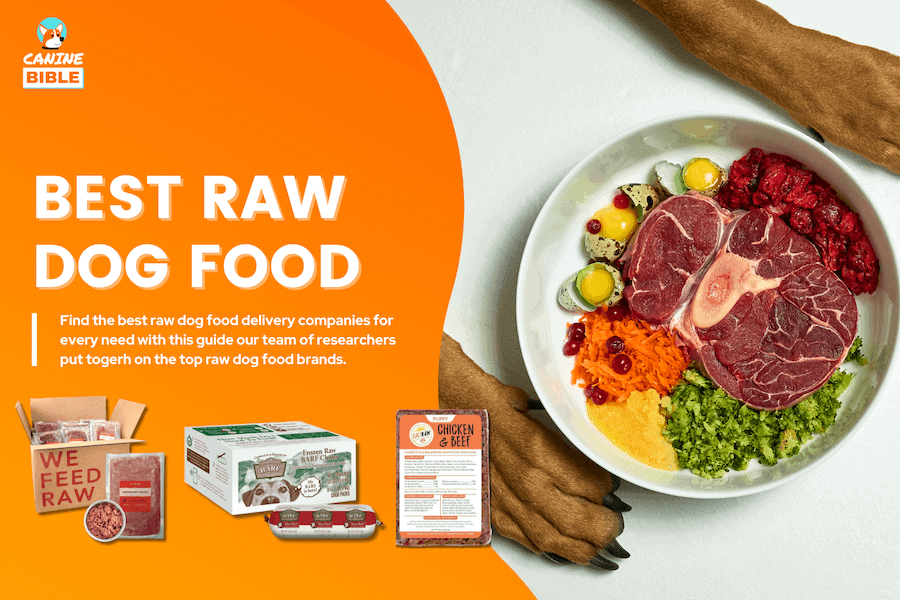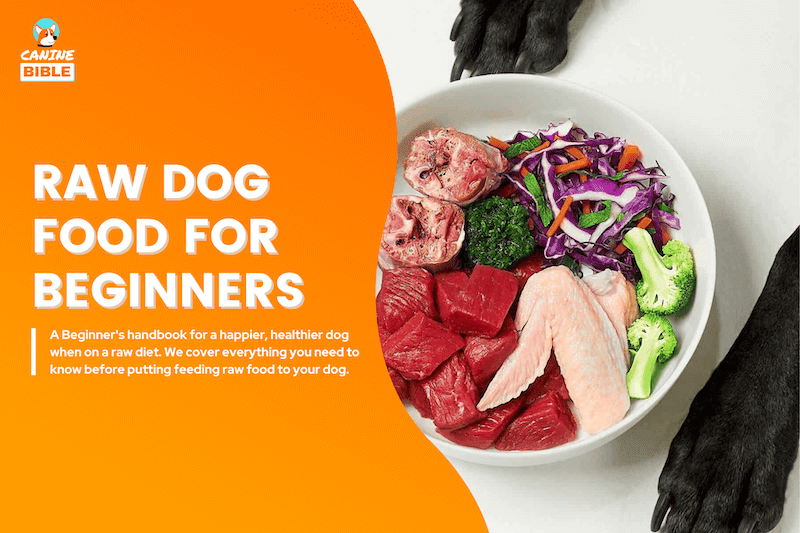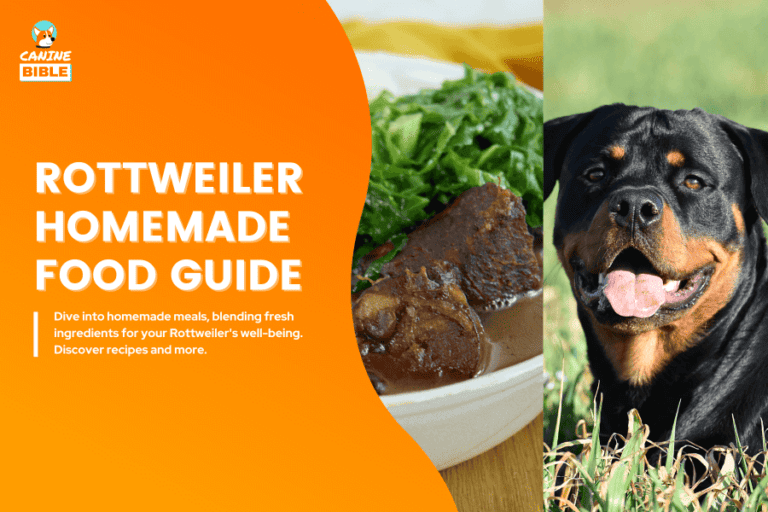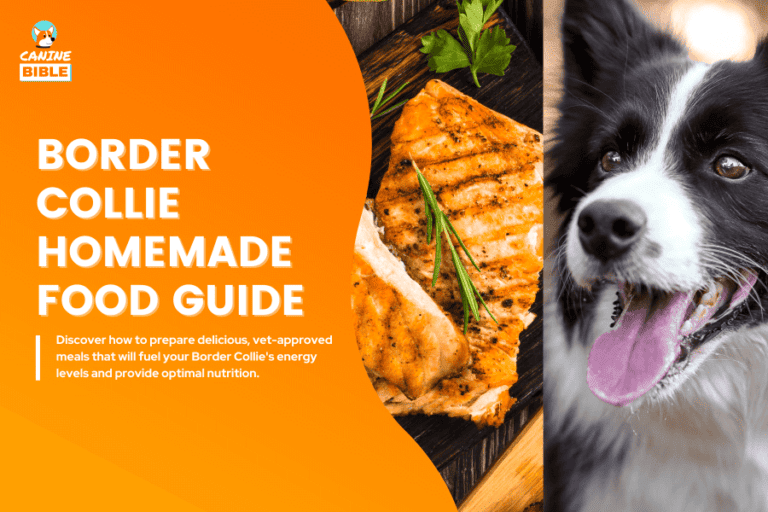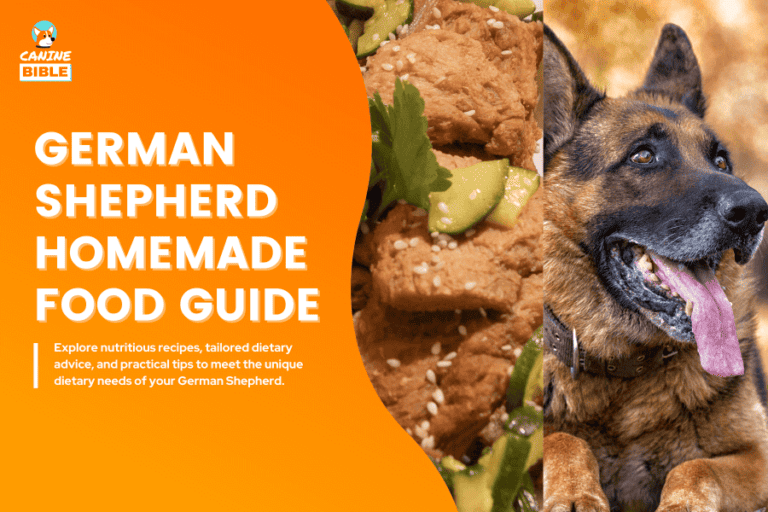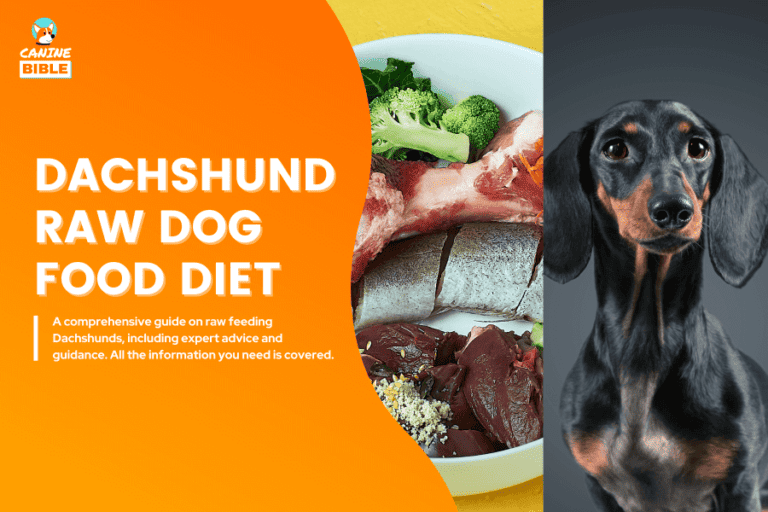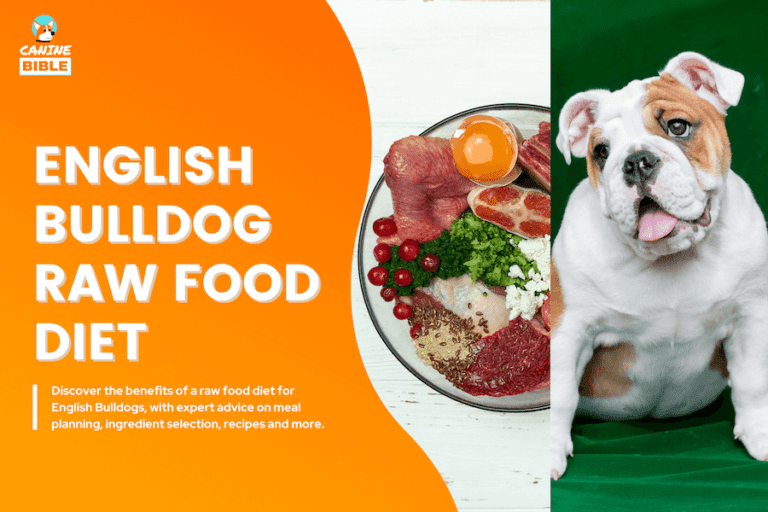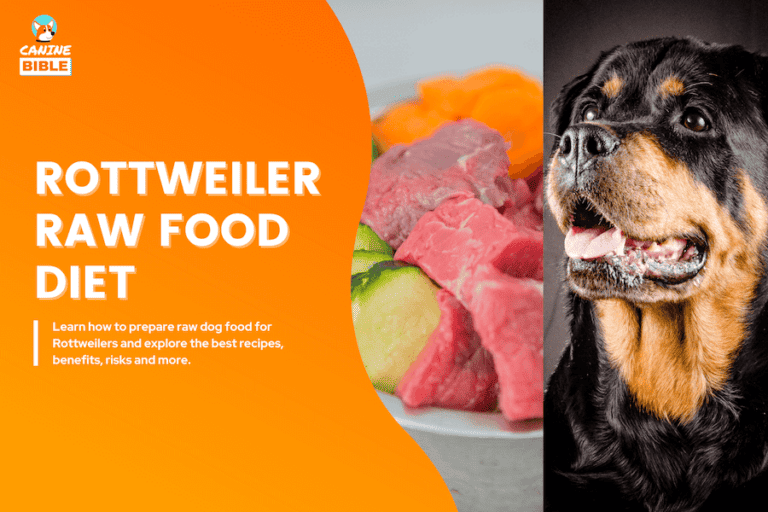Raw Diet For Dogs: Everything You Need to Know
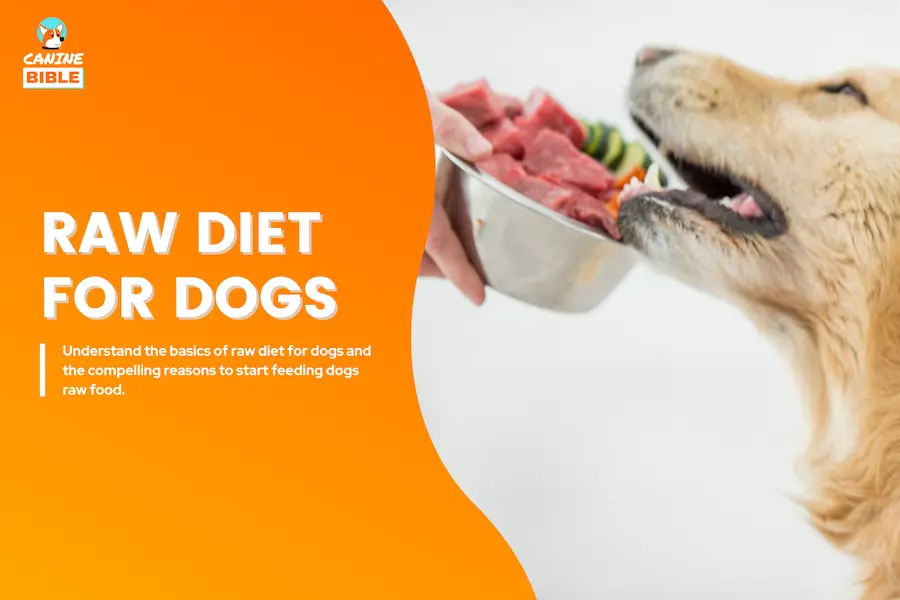
Canine Bible is reader-supported. We receive affiliate commissions via some of our links. This doesn’t affect rankings. Learn more.
You’re not alone if you’ve considered feeding your dog a raw diet. A growing number of dog owners are feeding their companions a raw diet. This article will explore a raw diet, its benefits and risks, and recent research. We’ll also provide practical advice on properly implementing a raw diet for your dog if you decide raw feeding is a good fit. Let’s get started!
What Is A Raw Diet For Dogs?
A raw diet for dogs, often referred to as BARF (Biologically Appropriate Raw Food), is a dietary approach that emphasizes feeding pets a diet consisting of uncooked ingredients. This diet is designed to mimic the natural eating habits of wild ancestors of dogs, aiming to provide a more biologically appropriate meal regimen than what is found in most commercial pet foods. A raw diet for dogs typically includes ingredients typically include:
A variation of a BARF diet is known as the “prey model raw (PMR)” food. The prey model excludes fruits, dairy, and vegetables.
History
The concept of raw feeding is inspired by the diet of wild canines, which consists mainly of prey animals. Proponents of raw diets argue that domestic dogs have digestive systems similar to their wild counterparts, suggesting they are naturally adapted to digest raw meat and bones. Sled dogs and racing greyhounds were the first to start eating raw diets before they were popular.
Australian veterinarian Ian Billinghurst introduced the concept of raw feeding in 1993 and coined BARF, which stands for Bones and Raw Food or Biologically Appropriate Raw Food. He proposed that dogs would thrive on a diet that resembles what they would eat in the wild, coining the term “Biologically Appropriate Raw Food” or BARF. The modern raw feeding movement gained traction in the late 20th century.
Types of Raw Diet For Dogs
Commercial Raw Diets
These are pre-packaged and available in pet stores or online. They typically come frozen. Commercial raw diets are formulated to meet a dog’s nutritional needs and are convenient for pet owners. Commercial raw foods are generally sold in large blocks, chubs, tubs, or pre-portioned patties. This raw diet must be stored frozen for the stage and thawed before serving. You will need freezer storage space if you get this food for your dogs.
Freeze Dried Raw Dog Food
This raw diet has been freeze-dried to remove moisture, preserving most of the raw ingredient nutrients, flavor and texture without refrigeration. Freeze-dried raw food is lightweight, shelf-stable, and needs rehydration before feeding. Freeze-dried is easy to portion and transport, making it a convenient option for pet owners who travel, dislike handling raw meat, or lack the freezer space to dedicate to their dog’s food. Think of freeze-dried raw food as offering raw nutrition in a kibble-like format.
Homemade Raw Dog Food
This involves pet owners sourcing and preparing the raw ingredients themselves. While it allows for more control over the ingredients, it requires a good understanding of canine nutrition to ensure the diet is balanced. Preparing your raw homemade dog food poses a higher risk of contamination and mis-balancing nutrients, resulting in poor nutrition that could have long-term consequences on your pet’s health. However, some pros of raw homemade meals allow you to source safe ingredients for your dog. Plus, it’s usually cheaper to buy your raw ingredients.
Raw Diet For Dog Benefits
Raw food has several positive effects on canine health, including shinier coats, improved skin health, more energy, lean and strong muscles, smaller and firmer stools, improved dental health, a stronger immune system, lower risk for allergies, better digestion, increased agility, brighter eyes, faster nutrient absorption, and weight management, among others.
Why Feed Raw Food According to Research
Raw Diet For Dogs Risks
While raw feeding dogs has benefits, and some veterinarians may recommend it, you should be aware of some concerns.
- Feeding whole bones to dogs presents a risk of choking, broken teeth, intestinal obstruction, or internal punctures.
- Raw meat is more likely to be contaminated by bacteria and pathogens, which can threaten the health of dogs and humans.
- You can jeopardize your dog’s health if you do raw or homemade food wrong (nutritionally unbalanced).
Are Commercial Raw Meat-Based Diets Unsafe For Dogs?
Commercial raw meat-based diets (RMBD) do not pose any risks. Raw dog food companies address the risks and concerns about raw diets by formulating their recipes to meet the nutritional levels established by the Association of American Feed Control Officials (AAFCO). To avoid contamination, they use high-quality ingredients, including USDA-certified meats and fresh vegetables. Furthermore, they finely ground the bones to reduce any risk of chowing. The FDA regulates and has guidance documents for all pet food products, including commercially available raw food for pets. The American Kennel Club has recommended commercial raw dog food formulas on their website.
When Should Dogs Avoid Raw Food?
Dr. Doug Knueven, who specializes in holistic medicine and consults for Nature’s Variety (Instinct, a raw dog food brand), says raw diets are inappropriate for all dogs. Because raw diets are typically high in protein, they aren’t appropriate for dogs with kidney or liver issues. Too much protein can increase the workload on these organs, leading to aggravation of these conditions. It’s recommended that dogs with pancreatitis or other digestive problems start with a cooked homemade diet to rule out issues before switching to raw. Dr. Knueven also states that dogs with cancer, those on chemotherapy, or those with other immunosuppressive conditions should not eat raw food.
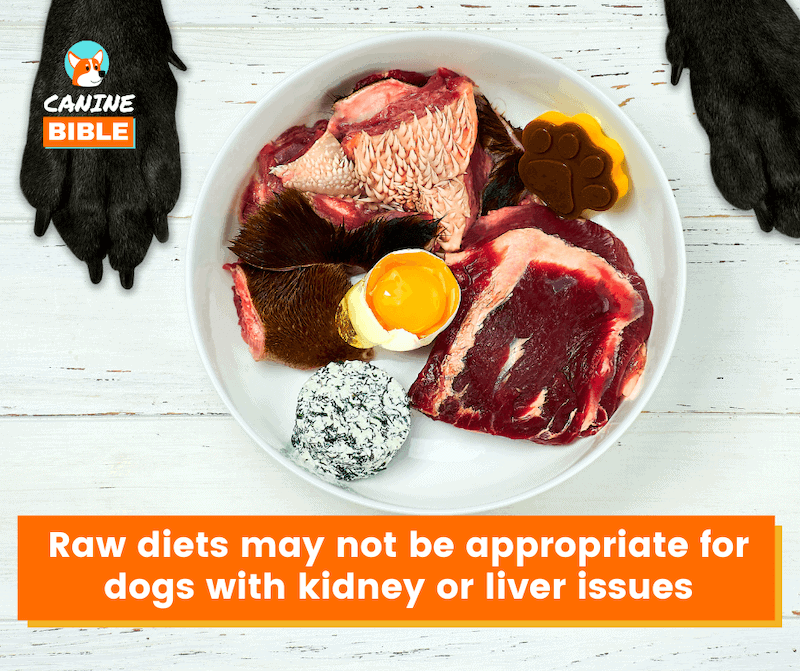
Raw Dog Food Pros & Cons
Let’s examine the pros and cons of feeding raw meals to canines.
Cost of Raw Food Diet For Dogs
The average cost of traditional kibble is $1.97 per pound, while premium kibble is around $3.47 per pound.[13] High-end raw commercial dog foods average $6.40 per pound, with cheaper raw options at $3.80 per pound. For reference, the U.S. Bureau of Labor Statistics lists average prices per pound of beef, chicken, and turkey at $3.90, $1.50, and $1.28, respectively. Switching your dog to a homemade raw diet could be comparable or cheaper than kibble. Commercial raw meat foods are slightly more expensive than kibble, but the health benefits and convenience may be worth the extra cost. Check out our ‘feeding raw dog food on a budget‘ guide for cost-saving tips.
Where to Buy Raw Dog Food?
Specialty pet stores are a good place to start your search for raw dog food. These stores typically carry a variety of brands and formulas, so you’re sure to find something that your dog will love. However, keep in mind that specialty pet stores can be pricey. Another option is to purchase raw dog food online. This is our preferred option. Many reputable retailers sell raw dog food at a reasonable price. Just be sure to research before making a purchase, as not all online retailers are created equal. Thankfully, we’ve researched this for you. Check out our article on the best raw dog food delivery services. Finally, you may be able to find raw dog food at your local grocery store or butcher shop. While the selection may be limited, you may be able to find a good quality product at a more affordable price.
Raw Food Diet For Dogs with Allergies
Many dogs suffer from allergies. Feeding your dog a raw food diet is one option to provide relief. Raw food diets are often hypoallergenic, as they do not contain fillers or preservatives that can trigger allergies. In addition, the nutrients in raw food are more easily absorbed by the body, which can help to reduce inflammation and support the immune system. A BARF diet mimics your dog’s natural diet, normalizing and strengthening your dog’s digestion and immune systems naturally, which reduces stress on the body while allowing a natural reduction of inflammatory conditions and a lower risk of infection and allergies. However, some dogs may be allergic to certain raw ingredients. Consider doing an at-home raw dog food allergy test if you’re considering a raw food diet for your allergic dog. Also, please consult your veterinarian first to ensure it is the best option for your pet.
Understanding The Basics of Preparing A Raw Diet
From understanding what ingredients are safe to how to handle raw food properly, our “Raw Dog Food for Beginners” guide will give you more specific insights and concepts you need to understand and keep in mind before you get out of the apron.
Raw Diet For Dogs Before And After
Watch and read before and after raw dog diet testimonials from parents who feed their dogs raw food.
Frequently Asked Questions
Should You Feed Raw Diet For Dogs?
The debate over whether or not to feed dogs a raw diet has been going on for years. Some people swear by the benefits of feeding their dogs a raw diet, while others are convinced that it is dangerous and harmful to their pet’s health. So, what is the truth? Is a raw diet suitable for your dog?
The answer may depend on who you ask, but there are pros and cons to consider before deciding. One of the biggest advantages of feeding a raw diet is that it is thought to be more natural and closer to what dogs eat in the wild. Proponents of raw diets also claim that these diets can improve digestion, help with weight management, and increase energy levels. However, some risks are associated with feeding a raw diet, including the potential for foodborne illness and spreading bacteria. Additionally, raw diets can be expensive and time-consuming to prepare.
Ultimately, you will need to decide whether to feed your dog a raw diet based on your research and discussion with your veterinarian. There is no definitive answer as to whether a raw diet is the best option for every dog, but understanding the pros and cons is crucial if you decide to switch your dog to raw feeding.
Like It? Subscribe & Share!
Sources
Canine Bible uses only high-quality sources, including peer-reviewed studies, to support the facts within our articles. Read our editorial process and product review methodology to learn more about how we fact-check, test products, and keep our content accurate, reliable, and trustworthy.
- Lippert, G., & Sapy, P. (n.d.). Analysis of the longevity of dogs. UKRMB.
- Darwin’s Natural Pet Products. (n.d.). BARF Diet: Raw Pet Food Diets. Darwin’s Pet.
- American Veterinary Medical Association. (2008). Raw or undercooked animal-source protein in cat and dog diets. Journal of the American Veterinary Medical Association, 232(5), 687-697.
- Honey’s Real Dog Food. (2020). The Raw Proof Report. Honey’s Real Dog Food.
- WebMD. (n.d.). Raw Dog Food: Dietary Concerns, Benefits, and Risks. WebMD.
- University of Helsinki. (n.d.). BARF poster. DogRisk.
- University of Helsinki. (n.d.). Puppy’s diet seems to be a significant factor in the development of allergy and atopy-related skin symptoms. University of Helsinki.
- The effect of puppyhood and adolescent diet on the incidence of chronic enteropathy in dogs later in life. (n.d.). Scientific Reports.
- Podolsky, A. (2019, November 28). Feed the dog not the cancer: The danger of processed dog food. Lyka.
- Harvard Health Publishing. (2018, May). Eating highly processed foods may raise cancer risk. Harvard Health; Harvard Health.
- University of Helsinki. (n.d.). Diet and neoplasia in dogs. DogRisk.
- Hielm-Björkman, A. (n.d.). Thesis on dog diet and health. Helda.
- Average price of of dry pet food by type U.S. 2019. (n.d.).
Canine Bible authorship represents the unified voice of our entire editorial team and our in-house veterinarians rather than a single author. Each article, blog post, and review published under the Canine Bible name undergoes a rigorous review process, involving all team members to guarantee accuracy and up-to-date in accordance with the latest veterinarian research. This collaborative effort is an integral part of our editorial process and aligns with our four pillars of content creation. This approach ensures our content is backed by expert knowledge and factual information, offering our readers reliable, actionable, and trustworthy content.

